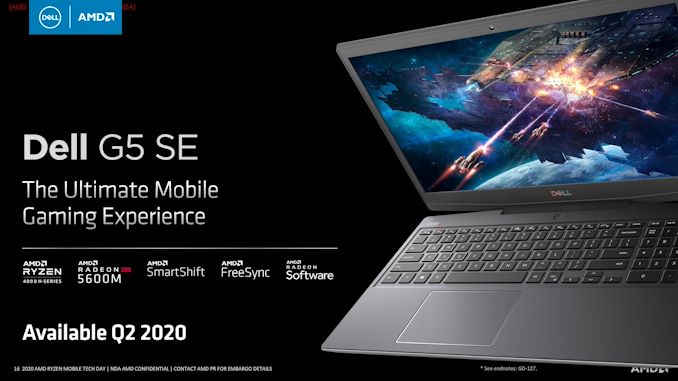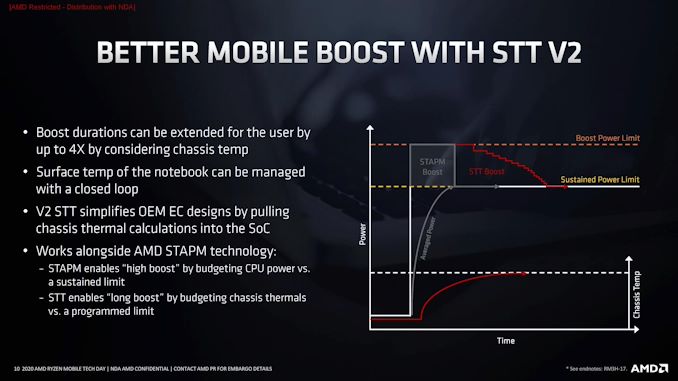AMD Details Renoir: The Ryzen Mobile 4000 Series 7nm APU Uncovered
by Dr. Ian Cutress on March 16, 2020 11:00 AM ESTAMD SmartShift
We’ve covered AMD’s SmartShift before, when it was announced at CES, as a technology that allows a system management controller to interact with both the mobile APU and an AMD graphics card in the same system in order to shift power where it is needed. This solution is still based on separate power rails between the two, however the use of the scalable control fabric (SCF) part of Infinity Fabric means that parts of the APU and parts of the GPU can interact together in this way. Ultimately AMD believes they can score 10-12% better on heavy CPU workloads like CineBench or gaming workloads like The Division.
The solution is firmware based, but requires interaction between qualified hardware. AMD states that often in these sorts of CPU+GPU designs, while the chassis has a total design TDP, if one of the elements of the system is idle, then the other can’t take advantage of the extra turbo headroom available. SmartShift aims to fix that.
What’s new here is that AMD is primarily focus will be on Ryzen Mobile 4000 + Vega 10 style systems. The first one with SmartShift enabled will be the Dell G5 SE. The Dell G5 SE is being labelled as ‘the ultimate mobile gaming experience’, and will feature a new H-series processor, the Radeon RX 5600M, SmartShift, FreeSync, and have a 15-inch display. The unit will be coming out in Q2.
System Temperature Tracking (Version 2)
SmartShift is also part of a new System Temperature Tracking paradigm that AMD is implementing in its new APUs. Even if there is power headroom, a system can’t turbo if there isn’t thermal headroom. Smart Temperature Tracing v2 (or STTv2) is designed to help a system boost for longer by knowing more about the thermal profile of the device.
My placing additional thermal probes inside the system, such as on hot controllers or discrete GPUs, the readings of these can be passed through the Infinity Fabric to an embedded management controller. Through learning how the system thermals interact when different elements are loaded, the controller can determine if the system still has headroom to stay in turbo for longer than the current methodology (AMD’s Skin Temperature Aware Power Management). This means that rather than having a small number of sensors getting a single number for the temerpature of the system, AMD takes in many more values to evaluate a thermal profile of what areas of the system are affected at what point.
What STTv2 does at the end of the day is potentially extend the boost time for a given system, depending on its thermal capabilities. For example, the Lenovo Yoga Slim 7 which we are expecting for review only has a 15 W processor inside, but the chassis has been built for a 25 W TDP design, which means that STTv2 should kick in and provide the user with peak performance for longer.














95 Comments
View All Comments
Spunjji - Tuesday, March 17, 2020 - link
Oof. Thanks for sharing that, but I feel like I know more than I ever wanted to about CODECs... and still not enough :'Dikjadoon - Tuesday, March 17, 2020 - link
Codecs live or die by industry & content support. I don't see *anyone* major taking up H.266, much less EVC or LCEVC.The transition to AV1 is not merely technical, but also political. MPEG Group has sowed their own demise.
Two of H.265's patent pools backed away away, scared of AV1's enthusiasm. I don't see Sisvel's snivelling going far, even with the latest batch of patent "disputes". How is their VP9 patent pool going?...
VVC's bit-freeze is when...2021? It'll take years for decoding hardware and *nobody* is eager to run back to MPEG.
A good read: https://www.streamingmedia.com/Articles/ReadArticl...
March 2020 update: https://www.streamingmedia.com/Articles/News/Onlin...
MPEG, Sisvel, etc. missed the boat about a half decade ago.
name99 - Thursday, March 19, 2020 - link
Firstly, don't confuse the world as you wish it to be from the world as it is.Apple is all on on h.265, and ATSC3, the next US digital TV spec, already in preliminary usage in some markets, is based on h.265. When you stream netflix at 4K UHD, you're probably using h.265.
Secondly, be aware of the schedules.
For h.265, the first version of the spec was 2013. By Sept 2015 Apple released the A9 with 265 decode, and a year later the A10 with 265 encode.
BUT these were only exposed to the public in 2017 with iOS11. The point of the delay,
presumably, was to ensure a large enough critical mass of users already at the point of announcement.
This suggests that Apple will be planning a similar transition of their entire line to VVC, but it will take time -- maybe a decoder chip in 2023, an encoder in 2024, a public commitment to "the new Apple codec is VVC across all devices" in 2025.
The relevance of Apple is that Apple is something of the leader in this space. Sure, sure, there's a tiny world of open source renegades talking about Dirac and Opus and Matroska and suchlike. But in the real world of serious money, Apple generally represents the vanguard.
So these future codecs are interesting, yes. But they're also only going to be mainstream relevant (if you're with Apple) maybe late 2025, for everyone else maybe a year or so later?
name99 - Thursday, March 19, 2020 - link
Oh I realize I left out one point.We saw exactly the same stories back when h.265 became relevant. Here's a sample thread:
https://forums.anandtech.com/threads/h-264-vs-h-26...
Complain all you like about the existence of patent pools, but they are just not that big a deal to the big boys, especially hardware. So Apple, or your Samsung/LG/Sony TV has to pay 1, or 5 dollars per device. That's perfectly feasible in return for a spec that is both very good, and more or less legal certainty.
There's just no reason to believe the driving forces in 2025 are any different from those in 2015.
grant3 - Tuesday, April 14, 2020 - link
"they are just not that big a deal to the big boys, especially hardware"And yet it's "big boys" like intel, cisco, google, samsung, nvidia etc. and oh ya, APPLE, who are the founding members of the royalty-free Open Media alliance i.e. the developers of AV1.
Hifihedgehog - Monday, March 16, 2020 - link
How much later is later, guesstimate-wise? :)Kevin G - Monday, March 16, 2020 - link
I was expecting B550 around Computex (which is still a go last I checked). However with the recent outbreaks, I wonder how much has been pushed back or will simply be a preview then. Supply chains are disrupted at various points. I'm just curious what we know has been pushed back, what is still on schedule and what is likely to be affected that hasn't yet. I'd make for an interesting piece. :)AshlayW - Monday, March 16, 2020 - link
Asbolutely hyped to pick up a 4400G(?) for my Slim system. Currently has a 3400G but we are edging closer to me being able to play all the games I like at 1080p, on a single chip system.dianajmclean6 - Monday, March 23, 2020 - link
Six months ago I lost my job and after that I was fortunate enough to stumble upon a great website which literally saved me• I started working for them online and in a short time after I've started averaging 15k a month••• icash68.coMpeevee - Monday, March 23, 2020 - link
On a desktop APU it would make sense to separate CPU and GPU dies, there is plenty of space and yields would be higher. Of course the GPU side should be Navi and socket should be upgraded to 4 memory channels to allow a truly decent integrated GPU similar to 5500.